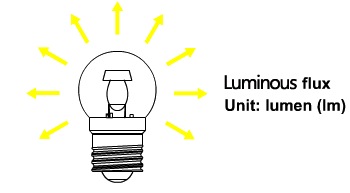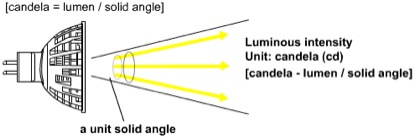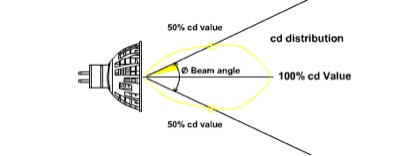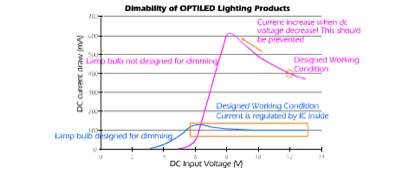1. Lumen (lm)
Lumen is the international (SL) unit of luminous flux, a measure of overall light emitted by a light source.

2. Candela (cd)
Candela is the international (sl) unit of luminous intensity, a measure of light emitted by a light source in a particular direction.
Any given light source will have different luminous intensities in different directions considered.
[Candela = lumen/solid angle]

3. Beam Angle [Unit: degree]
Beam angle is the angle between two directions for which the luminous intensity is 50% of the maximum intensity as measured in a plan through the nominal beam centerline. Beam angle of a bulb gives an idea of how the light beam spreads away from the beam center.

4. LUX (lx)
Lux is the international (SL) unit of illuminance, a measure of light arriving at a surface, 1 lumen per square foot equals 1 foot-candle, while 1 lumen per square meter equals 1 lux .
[lux = lumen/m2]

5. Color Temperature / Correlated Color Temperature(CCT)
A black-Body radiator will have a different color when it is heated up to different temperatures (in Kevin). The Temperature at which the heated black-body radiator matches the color of the light source is the color temperature of the light source.

6. Color Rendering Index (CR)
Color rendering index ranges from 0-100, measures a light source's ability to reproduce the color of various objects being lit by a reference light source, black body radiator (CRI=100)
7. Efficacy (lm/W)
Efficacy is the efficiency of a light source to concert electricity energy to light energy which is expressed in lumen output per unit power input (watt)
[Efficacy = lumen / wattage]
8. Design Life Time
Design lifetime is the average life of a lighting product when it is operated at nominal lamp voltage, current and controlled working environment. Actual lamp life varies because of any different from those rating condition.
9. Dimmability
Not all lighting products is designed for dimming function. Dimming a non-dimmable LED lighting product will cause un-predictable result and may affect the lifetime of the products. The below figure shows the typical input current variation while adjusting the DC voltage input to dimmable and non-dimmable product.

|
 +86-755-66809236
+86-755-66809236 +86-755-66809236
+86-755-66809236

